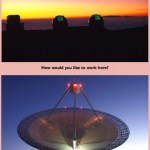astrophysics
So I've been hanging out at the Indirect and Direct Detection of Dark Matter conference this week, and been struck by several things.
It is a good meeting, enthusiastic crowd, definite excitement in the air.
It would have read much better if the title had been "Direct and Indirect Detection of Dark Matter", but that would have been wrong...
This is not my usual turf, though I was on a couple of papers on the adiabatic contraction of collisionless matter during growth of supermassive black holes, which is a way to get very high dark matter densities (QHS95 and SHQ95).
Basically a "spike" in…
By Dr. Paul EstradaPlanetary physicist at the Carl Sagan Center for the Study of Life in the Universe, SETI Institute, and Gail Jacobs
If planets are a dime a dozen, moons are less than a penny each. There are at least 139 moons just within our own solar system. Most of these are the property of the gas giant planets beyond Mars. More than just a nice accompaniment to planets, moons may have habitats in which liquid water could ebb and flow - and possibly be a suitable home for life. Planetary physicist Dr. Paul Estrada investigates how moons around gas giants are formed -- an important…
Don Backer, an astrophysicist at the University of California, Berkeley who discovered the first millisecond pulsar, died on July 25. He was director of Berkeley's Radio Astronomy Laboratory and the Allen Telescope Array (ATA) in Hat Creek, California - a collection of 42 dishes that recently began scanning the sky and searching for extraterrestrial intelligence.
"Memories of a special moment with Don Backer"
By Jill Tarter
Don and I had only a few glancing interactions from the time we were engineering physics students at Cornell until one memorable day in 1982. On that day I pulled my…
In the three years since he joined the Weizmann Institute, there have been four press releases on Dr. Avishay Gal-Yam's work as well a number of stories in our magazines. This may be somewhat unusual, but there is no denying the interest in his subject matter: supernovae.
Of the last two papers featured in the media, the first has all the pyrotechnical drama: a star the size of 200 suns, exotic electron-positron pairs sucking out its energy until it collapses on its own core and goes up in a mega thermonuclear explosion.
The second paper also describes a new type of supernova - one that's…
Via Jennifer Ouellette on Twitter, I ran across a Discovery News story touting a recent arxiv preprint claiming to see variation in the fine-structure constant. It's a basically OK story, but garbles a few details, so I thought it would be worth giving it the ResearchBlogging treatment, in the now-traditional Q&A format.
What did they do? The paper looks at some spectral lines in radio emission from a moderately distant galaxy with the poetic name "PKS1413+135." These lines are produced by OH molecules in interstellar gas clouds, and the frequencies they see suggest that there may have…
There's a minor kerfuffle at the moment over the XENON experiment's early data (arxiv paper) which did not detect any dark matter in 11 days of data acquisition. This conflicts with earlier claims by the DAMA experiment and recent maybe-kinda-sorta detections by the CoGeNT and CDMA experiments.
As a result, a couple of members of other collaborations have posted a response on the arxiv saying, basically, that they don't believe the sensitivity claimed for the XENON detector in the energy range in question, and that their result can't really be said to rule out the possibility of dark matter…
tags: Wonders of The Solar System, space exploration, astrophysics, spoof, parody, satire, humor, funny, fucking hilarious, Dr Brian Cox, BBC, television, streaming video
Here is an inspirational video trailer from BBC's television program, "Wonders of the Solar System", where series host, Dr Brian Cox, exclaims; "That's why I love physics so much, cuz physics is all about tryin' to work out WTF is goin' on."
Just though readers might be interested to know that we have a a non-Icelandic astrophysicist at ScienceBlogs now. Also, ScienceBlogs now has a photolog manned by a rotating crew. If you're not on a Lynx browser it might be worth your time.
We need one of those propaganda videos, like the Marines had when I was a kid:
Seriously, I remember watching that and actually thinking it would be awesome to be a Marine! (And for those of you who don't know me that well, I loathe armed conflict.)
Well, I'm a scientist. Can't we do anything cool to attract people to be interested in it, or help support it? Baby steps, folks, baby steps. And Duncan Forbes at Swinburne in Australia (where I almost moved when I was offered a position with them last February) has composed a how-to guide entitled:
So You Want To Be A Professional Astronomer!
It…
In my mind, and in my car,
we can't rewind, we've gone too far,
pictures came and broke your heart,
put the blame on VTR.
And for those of you who are under the age of 25, VTR stands for Video Tape Recorder. This was the Buggles, who made the first music video that ever appeared on MTV, back when MTV played music videos. (I wonder what the last music video on MTV was? My guess is California Love by Tupac and Dre back in 1996. At least, that's probably the last music video that I've ever seen on MTV.)
But why all this? Because I wanted to tell you about my appearance on The Space Show this…



